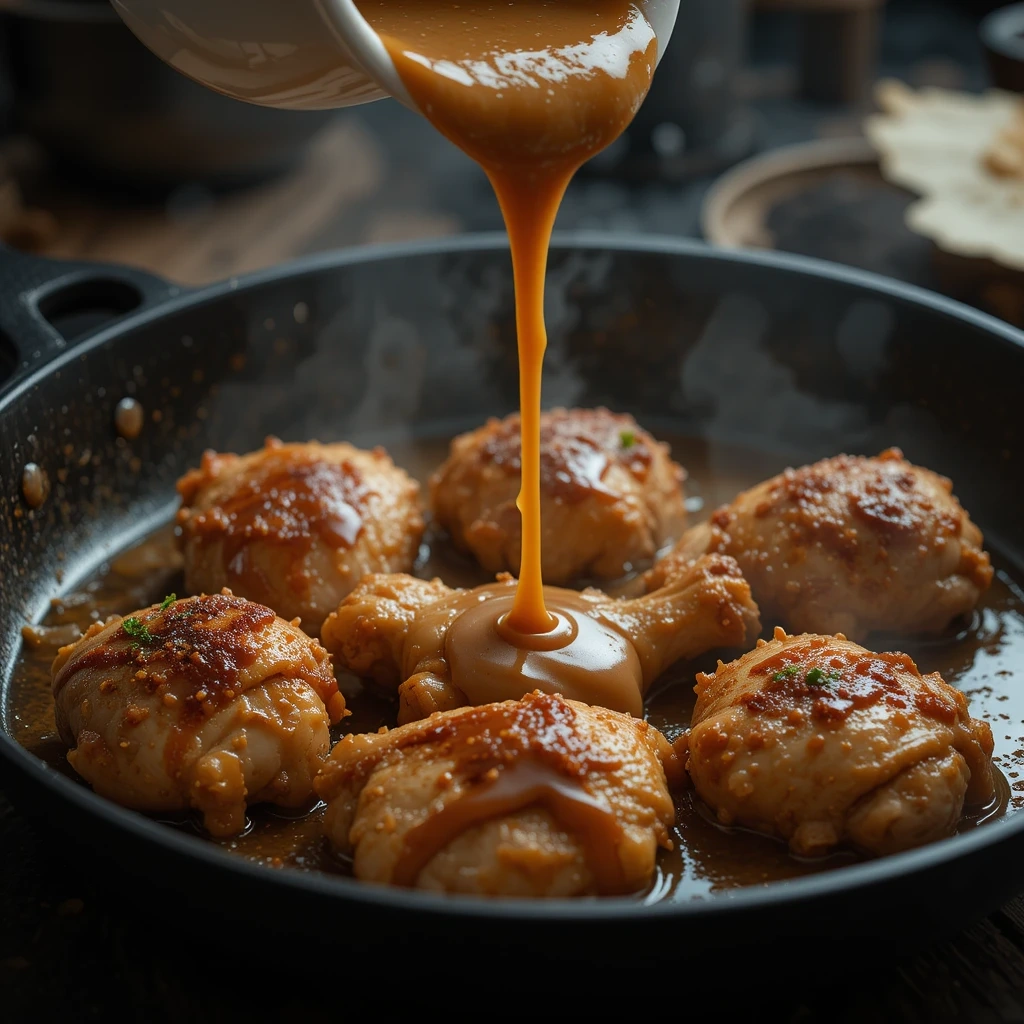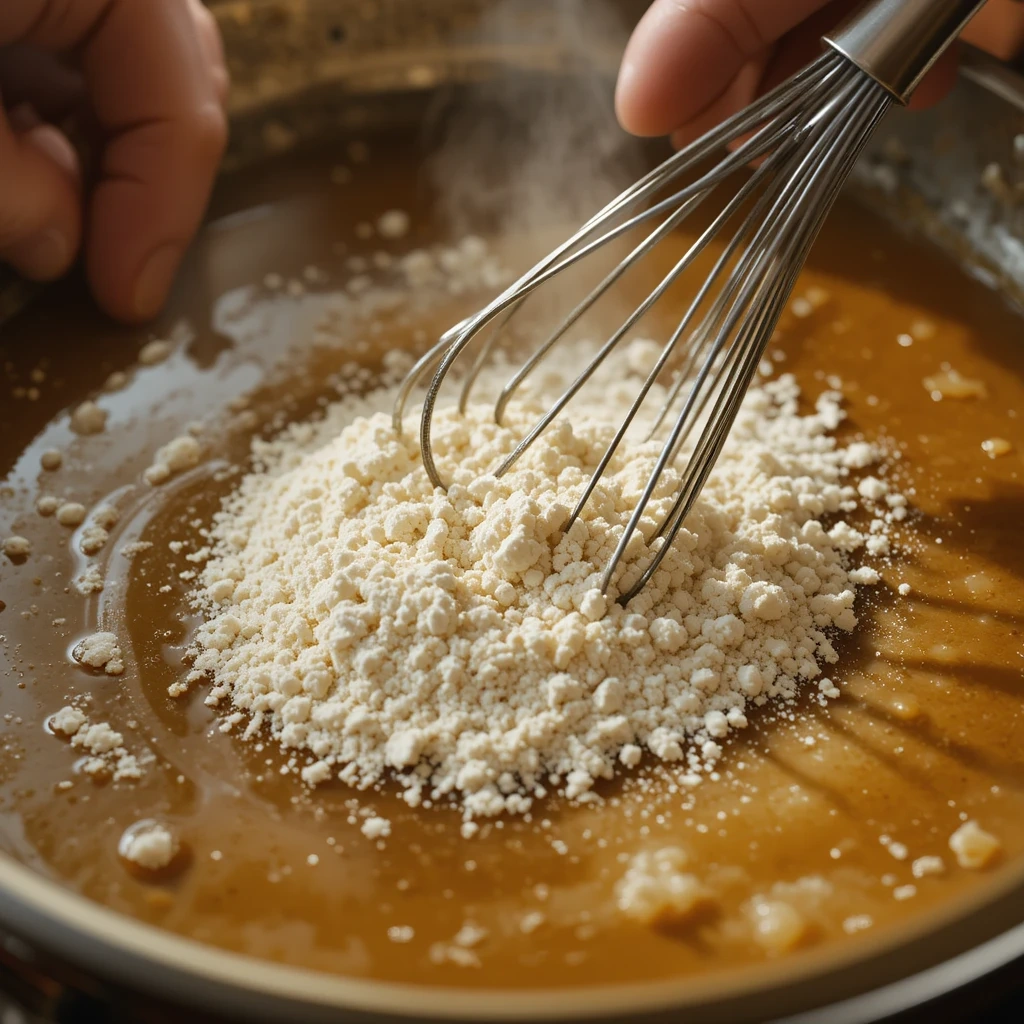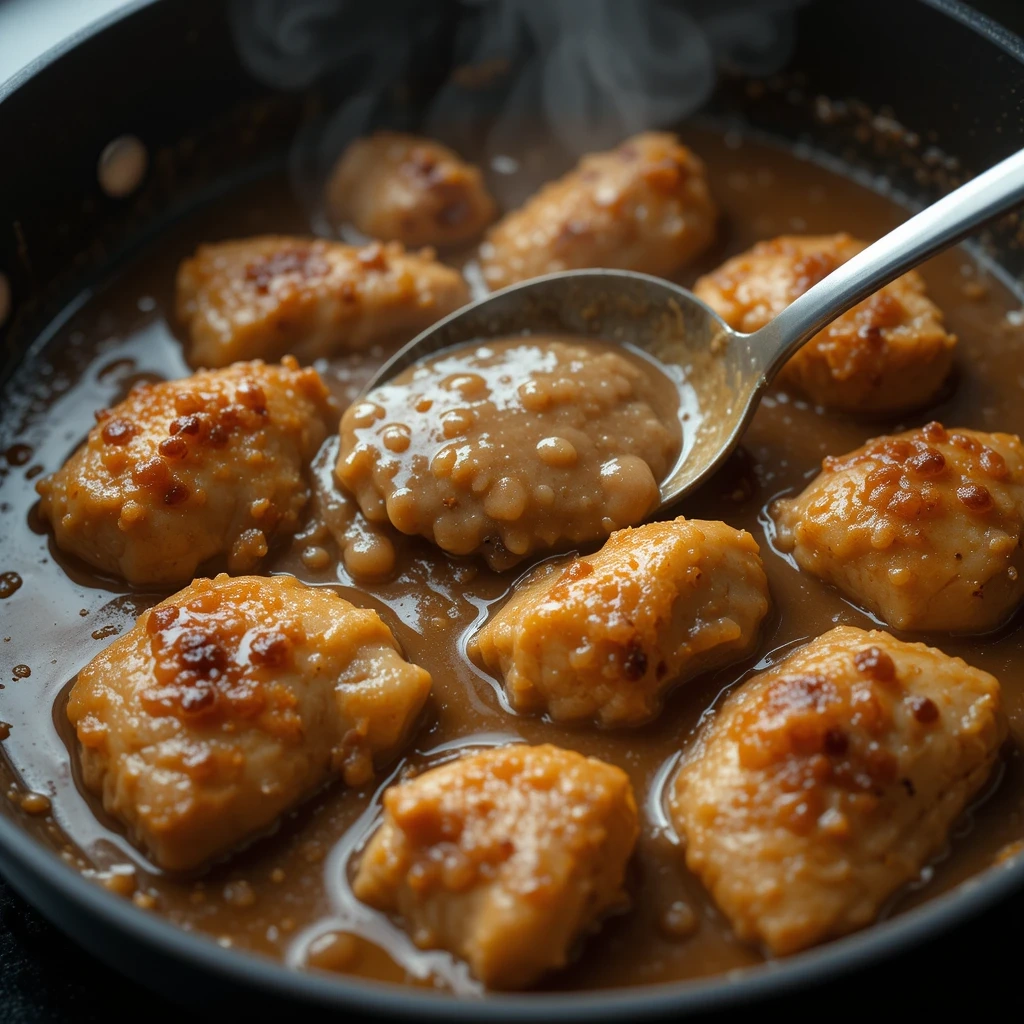Chicken and gravy is a classic comfort food dish cherished for its rich flavors and satisfying warmth. At its core, this recipe combines tender, well-seasoned chicken with a luscious, homemade gravy that enhances every bite. The process begins with selecting quality chicken pieces, often bone-in and skin-on for juiciness and flavor, which are seasoned and seared to develop a golden crust. The magic of the dish lies in crafting the gravy base—starting with a buttery roux infused with sautéed onions, then gradually whisking in chicken broth to create a smooth, flavorful sauce. As the chicken simmers gently in the gravy, it absorbs the savory goodness, resulting in a hearty meal perfect for pairing with mashed potatoes or rice. Mastering this dish involves attention to seasoning, cooking times, and gravy consistency, making it both a rewarding and nostalgic cooking experience that brings family and friends together around the table
When I first decided to tackle the art of making chicken and gravy, I quickly realized that the success of the dish hinges on having the right ingredients and tools at my disposal. I remember standing in the grocery store, staring at the endless rows of spices and sauces, trying to recall the recipe I had seen online. I made a mental checklist: fresh chicken, flour, chicken broth, and a medley of spices.
I also grabbed some butter and onions, knowing they would add depth to the flavor. It was a simple yet satisfying experience, feeling like a chef preparing for a culinary adventure. In addition to the ingredients, I made sure to gather my kitchen tools.
A sturdy skillet was essential for searing the chicken, while a whisk would be my trusty companion for making the gravy. I also pulled out my favorite wooden spoon, which has seen many meals come to life in my kitchen. As I laid everything out on the counter, I felt a sense of excitement bubbling within me.
The anticipation of creating something delicious was palpable, and I couldn’t wait to get started.
Preparing the Chicken
With my ingredients and tools ready, it was time to prepare the chicken. I opted for bone-in, skin-on chicken thighs because they tend to be juicier and more flavorful than their boneless counterparts. As I rinsed the chicken under cold water, I recalled a time when I had made the mistake of skipping this step.
The result was a dish that tasted less than fresh. This time, I made sure to pat the chicken dry with paper towels, ensuring a nice sear when it hit the hot skillet. Next came the seasoning.
I generously sprinkled salt and pepper over each piece, followed by a dash of garlic powder and paprika for an extra kick. I remember my grandmother always saying that seasoning is key to elevating any dish, and her words echoed in my mind as I rubbed the spices into the chicken. Once seasoned, I set the chicken aside to let the flavors meld while I prepped for the next step.
Table of Contents
Making the Gravy Base
Creating a rich gravy base is where the magic truly happens in this dish. I heated a generous amount of butter in my skillet until it melted and began to bubble. The aroma of butter sizzling in the pan brought back memories of family dinners where gravy was always a staple.
As I chopped an onion and tossed it into the skillet, I could almost hear my family’s laughter echoing around the table. After the onions became translucent and aromatic, I incorporated flour to form a roux. This step can be tricky; too little flour can lead to a watery gravy, while too much can make it overly thick.
I remember my first attempt at making gravy ended in disaster when I didn’t measure properly. This time, I carefully whisked in just enough flour until it formed a paste-like consistency. Gradually, I poured in chicken broth while whisking continuously, watching as the mixture transformed into a smooth base that promised to be rich and flavorful.

Cooking the Chicken
| Recipe Step | Time | Temperature |
|---|---|---|
| Preheat oven | 10 minutes | 375°F |
| Cook chicken | 45 minutes | 375°F |
| Rest chicken | 5 minutes | N/A |
With my gravy base ready, it was time to cook the chicken. I carefully placed each piece into the hot skillet, skin-side down, allowing them to sear beautifully. The sound of sizzling chicken filled my kitchen, and I couldn’t help but smile at how satisfying it was to see everything come together.
As I cooked them for about five minutes on each side, I reminisced about family gatherings where my mother would prepare her famous fried chicken. The anticipation of that crispy skin was something I wanted to replicate. Once the chicken was golden brown, I poured the gravy base over it and covered the skillet with a lid.
This step allowed the chicken to braise gently in its own juices while absorbing all those delicious flavors from the gravy. As it simmered away, I took a moment to reflect on how cooking is not just about following recipes; it’s about creating memories and sharing love through food.
Warm up with the comforting flavors of the Easy Chicken and Gravy recipe from Cooking in the Midwest. This one-pan dish features tender chicken breasts simmered in a savory homemade gravy made from butter, flour, and chicken broth, seasoned with herbs and spices like oregano, thyme, paprika, onion powder, and garlic powder. Ready in under 30 minutes, it’s a perfect weeknight meal that pairs wonderfully with mashed potatoes, rice, or your favorite vegetables.

Thickening the Gravy
As the chicken cooked, I kept an eye on the gravy, eager to achieve that perfect consistency. After about 30 minutes of simmering, I noticed that while it was flavorful, it could use a little thickening. In my early cooking days, I often struggled with this part—either ending up with gravy that was too thin or too gloppy.
This time, however, I had learned from experience. I decided to create a slurry using cornstarch and cold water—a trick I picked up from a cooking show that had saved me more than once. After whisking it together until smooth, I slowly added it to the simmering gravy while stirring continuously.
Almost instantly, I watched as it thickened beautifully without clumping. The transformation was gratifying; it was as if my dish was finally coming into its own.

Seasoning and Serving
The Taste Test
With everything cooked to perfection, it was time for one final taste test before serving. As I dipped a spoon into the gravy and tasted it, I felt like a judge on a cooking competition show—anxious yet excited. It needed just a pinch more salt and a sprinkle of black pepper to elevate those flavors even further.
A Family Tradition
Once satisfied with the seasoning, I plated up the chicken alongside creamy mashed potatoes and drizzled that luscious gravy over everything. As I set the table for dinner, memories flooded back of my childhood dinners where we would gather around as a family to enjoy home-cooked meals like this one. The aroma wafting through my home felt like a warm embrace, inviting everyone to come together and share stories over good food.
A Delicious Outcome
When my family finally sat down to eat, their delighted expressions made all the effort worthwhile.
Discover the ultimate Chicken Bryan recipe at Veibrant Recipes—a flavorful Italian-American dish featuring grilled chicken breasts topped with creamy goat cheese, sun-dried tomatoes, and a rich lemon butter sauce. This comprehensive guide offers step-by-step instructions, from selecting high-quality ingredients to mastering the art of grilling and sauce preparation. Perfect for both novice and experienced cooks, this recipe brings a restaurant-quality meal to your home kitchen.veibrantrecipes.com+2veibrantrecipes.com+2veibrantrecipes.com+2
Tips for Perfecting the Dish
Reflecting on my journey of creating this chicken and gravy dish, I’ve gathered some tips that can help anyone looking to perfect their own version. First and foremost, don’t rush through any steps—especially when it comes to seasoning and cooking times. Allowing flavors to develop is crucial for achieving that rich taste we all crave in comfort food.
Additionally, using high-quality ingredients can make a significant difference; fresh herbs or homemade broth can elevate your dish from good to extraordinary. Another tip is to experiment with different herbs and spices based on your preferences. While classic salt and pepper are essential, adding thyme or rosemary can introduce new dimensions of flavor that will surprise your palate.
Lastly, don’t be afraid to make adjustments as you go along; cooking is an art form that thrives on creativity and personal touches.
5 Common Mistakes to Avoid and Their Solutions
Throughout my culinary journey with chicken and gravy, I’ve encountered several common pitfalls that can derail even the best intentions. One mistake is not properly seasoning the chicken before cooking; this can lead to bland meat that lacks character.
The solution? Always season generously and taste as you go along. Another common error is rushing through cooking times—especially when searing chicken. If you don’t allow enough time for that golden crust to form, you’ll miss out on flavor and texture. Patience is key here; let your chicken develop that beautiful color before flipping it over. A third mistake is neglecting to whisk continuously when adding broth or thickening agents like cornstarch; this can result in lumps ruining your gravy’s smooth texture.
To avoid this, keep your whisk moving! Additionally, many people forget about resting their meat after cooking; cutting into it too soon can cause juices to run out, leaving you with dry chicken instead of juicy perfection. Allowing your chicken to rest for a few minutes will ensure every bite is tender and flavorful. Lastly, not adjusting seasoning at the end can lead to an unbalanced dish. Always take that final taste before serving; sometimes all it takes is a pinch of salt or dash of pepper to elevate your creation from good to great!
FAQs
What ingredients and kitchen tools do I need to gather for this chicken and gravy dish?
You will need chicken pieces, flour, butter, chicken broth, milk, salt, pepper, garlic powder, onion powder, paprika, and a few kitchen tools such as a skillet, whisk, and measuring cups.
How should I get the chicken ready for this meal?
First, you will need to season the chicken pieces with salt, pepper, and any other desired seasonings. Then, you will dredge the chicken in flour before cooking it in a skillet with butter.
What is the process for making the gravy base?
After cooking the chicken, you will use the drippings in the skillet to create a roux by adding flour and whisking it with the remaining butter. Then, you will gradually add in the chicken broth and milk while continuing to whisk until the mixture thickens.
How do I cook the chicken for this dish?
You will cook the chicken in a skillet over medium heat, ensuring that it is cooked through and golden brown on both sides.
How do I thicken the gravy for this dish?
To thicken the gravy, you will gradually add a mixture of flour and water to the simmering gravy while whisking constantly until it reaches your desired consistency.
How should I season and serve the chicken and gravy dish?
You can season the dish with additional salt, pepper, or any other desired seasonings before serving it hot over rice, mashed potatoes, or with a side of vegetables.
What are some tips for perfecting this chicken and gravy dish?
Some tips for perfecting this dish include ensuring that the chicken is fully cooked, adjusting the seasonings to taste, and allowing the gravy to simmer and thicken to the desired consistency.
What are 5 common mistakes to avoid when making this dish and their solutions?
Common mistakes to avoid include burning the roux, overcooking the chicken, not seasoning the dish enough, not allowing the gravy to thicken properly, and not adjusting the seasonings to taste. Solutions include closely monitoring the roux, using a meat thermometer to check for doneness, tasting and adjusting the seasonings as needed, and allowing the gravy to simmer and thicken before serving.

chicken and gravy recipe
Ingredients
- Bone-in skin-on chicken thighs
- All-purpose flour
- Butter
- Chicken broth
- Salt
- Black pepper
- Garlic powder
- Paprika
- Onion chopped
- Cornstarch for thickening
- Cold water for slurry
- Pros
- Creates a rich flavorful comfort meal
- Uses simple accessible ingredients
- Perfect for family gatherings
- Versatile dish that pairs with many sides
- Leftovers taste even better the next day
- Cons
- Requires attention to detail for proper gravy consistency
- Can be time-consuming with multiple steps
- High in calories and fat
- Requires practice to perfect the thickening technique
- Easy to over-season if not careful
Instructions
- Rinse chicken under cold water and pat dry with paper towels.
- Season chicken generously with salt, pepper, garlic powder, and paprika.
- Heat butter in a skillet until melted and bubbling.
- Add chopped onions to the skillet and cook until translucent.
- Incorporate flour to form a roux, whisking carefully to avoid lumps.
- Gradually pour in chicken broth while continuously whisking to create a smooth gravy base.
- Place seasoned chicken pieces into the hot skillet, skin-side down, and sear for about 5 minutes on each side until golden brown.
- Pour the gravy base over the chicken, cover the skillet with a lid, and let simmer.
- Cook for approximately 30 minutes, allowing the chicken to braise in the gravy.
- If needed, create a slurry with cornstarch and cold water to thicken the gravy.
- Add the slurry to the simmering gravy while stirring continuously.
- Taste and adjust seasoning with additional salt and pepper if necessary.
- Serve hot over mashed potatoes or rice.

